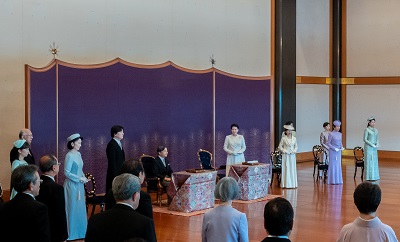Ceremony of the Utakai Hajime
(Imperial New Year's Poetry Reading)

A New Year Poetry Reading is a gathering of people who get together to read a collection of poems on a common theme to a wider audience. This practice was already in usage during the Nara Period, and became known through the famous volume of Japanese poetry, the Manyoshu.
An Imperial Poetry Reading is the same as the above-mentioned description, the only difference being that the poetry reading is convened by His Majesty the Emperor. As part of the annual events at the Imperial Palace, every month a Poetry Reading came to be held. Of these monthly Poetry Readings, the Imperial Poetry Reading was held as the first such party of the New Year, and was given the name Uta Gokai Hajime.
The origins of the Ceremony of the Utakai Hajime are unclear. During the mid-Kamakura period, on 15 January 1267, Emperor Kameyama convened a Poetry Reading at the Imperial Palace, which is recorded in the Gaiki Nikki as an internal ceremony. Since that time, records of the New Year's Poetry Reading can be found down through the ages. From such evidence, it can be surmised that the origins of the Ceremony of the Utakai Hajime are traceable to the mid-Kamakura period.
The Ceremony of the Utakai Hajime came to be held almost every year through the Edo period, and after the Meiji Restoration, the first Ceremony of the Utakai Hajime during the reign of Emperor Meiji was held in January 1869. Since then, among various reforms in ceremonies, the Utakai Hajime has continued to be held.
From 1874, poems written by the general public were admitted for consideration for the first time, and the Utakai Hajime in the Imperial Palace thus became open to the people of Japan, and no longer the preserve of members of the Imperial Family, grandees and their entourages.
In 1879, of the poems submitted by the general public, those considered to be of special merit were chosen to be read out at the Utakai Hajime. This was a ground breaking development in the history of the Ceremony of the Utakai Hajime and established the precedent for commoners to be included in the ceremony at the Imperial Palace.
Since 1882, all poems recited at the Ceremony of the Utakai Hajime including those by the Emperor and the specially selected poems have been published in newspapers and since 1884 they have been also published in the government gazette.
In 1926, the Imperial Family System Decree was promulgated, and this Decree mentioned the program of the Ceremony of the Utakai Hajime. Since then, the Utakai Hajime became formally known as Ceremony of the Utakai Hajime. However, due to the passing of Emperor Taisho in December 1926, the following year the Ceremony of the Utakai Hajime did not take place and the first year it took place with its new official name was 1928.
After World War II, the Poetry Department of the former Imperial Household Ministry was abolished and prominent poets from outside the confines of the Imperial Palace were appointed as poets to select poetry for the Ceremony of the Utakai Hajime. In addition, in order to elicit the submission of more poems from a wider range of people, the subject for the poems was made simpler. Furthermore, it became possible for those people whose poems were chosen to attend the Ceremony of the Utakai Hajime and have the opportunity to have an audience with Their Majesties the Emperor and Empress. The people who select the poems are those who are active in contributing to a wide variety of fields, and the number of people who attend the Ceremony of the Utakai Hajime to listen to the recitation of the poems has increased in size and scope. In addition, live television coverage has been introduced, bringing the spectacle of the Ceremony of the Utakai Hajime to an even wider audience and promoting national participation and enjoyment of the ceremony.
The Ceremony of the Utakai Hajime at the Imperial Palace boasts a long history and represents a ceremonial culture that has become more sophisticated with the reforms of the Meiji and post-war eras, to become a cultural event with national participation in a way that is unique in the world. Tanka poetry is said to be at the heart of all traditional culture in Japan. These tanka poems are submitted not only by people in Japan, but also by people around the world, and the annual ceremony at the Imperial Palace where the tanka are recited demonstrates their power to bind the people together with the Imperial Family, which is something to be truly praised and lauded.
The Ceremony of the Utakai Hajime is attended by Their Majesties the Emperor and Empress, and poems include those chosen from submissions by the general public, a poem of a selector, and a poem of an invited poet are recited. Finally, poems of the Imperial Family, Her Majesty the Empress and His Majesty the Emperor are recited. Members of the Imperial Family, including His Imperial Highness the Crown Prince are present at the Ceremony of the Utakai Hajime, and other audience members include the Minister of Education, Culture, Sports, Science and Technology, members of the Japan Academy of Art and the members of the public whose poems have been chosen.
The ceremony is performed through several participants, each with special titles: dokuji (master of ceremonies), koji (reader of all verses), hassei (singer from the first verse), and kosho (accompanying singer to the hassei from the second verse).